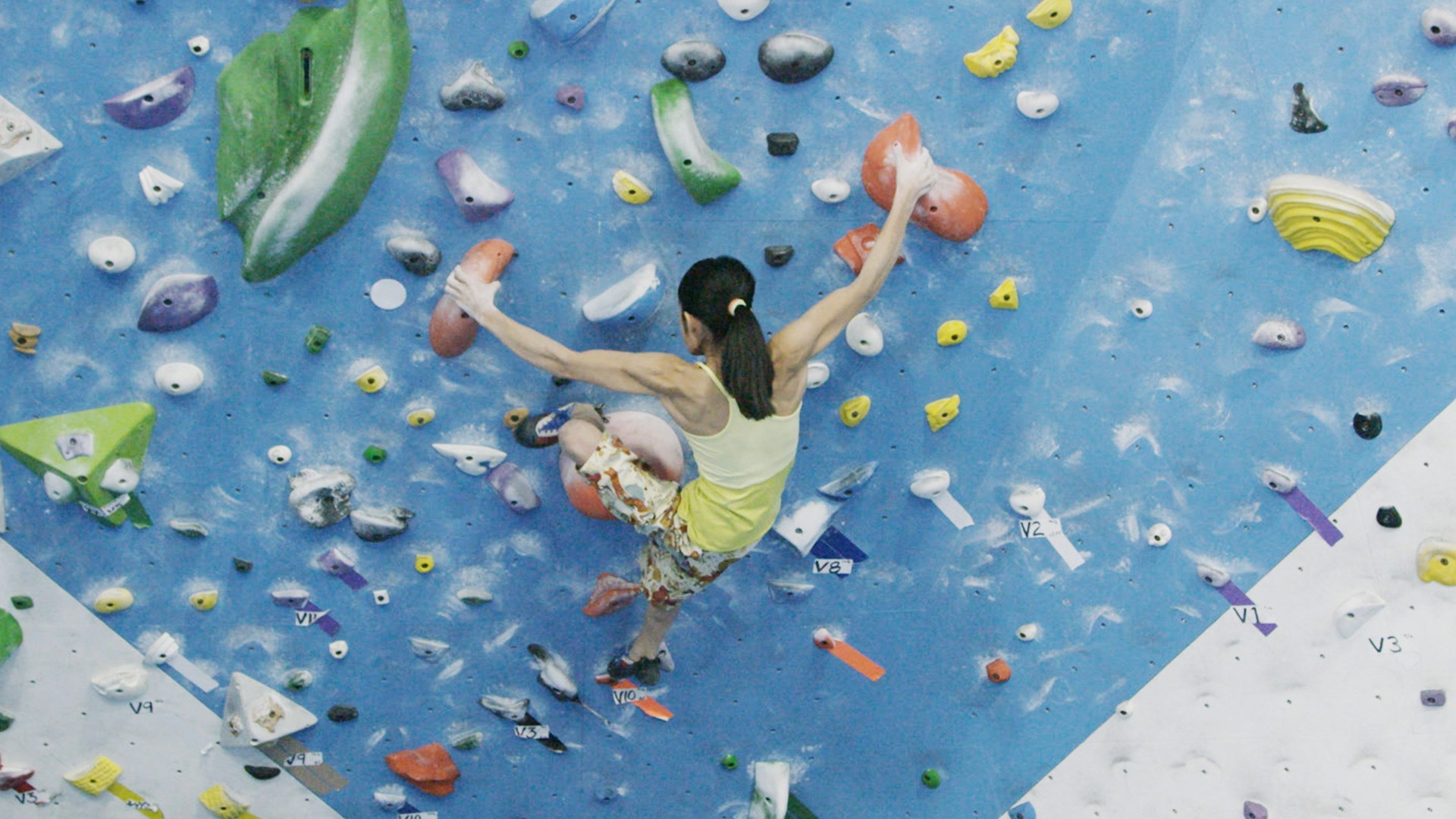Lauren Lubin runs in this weekend's New York City Marathon. Photo courtesy Lauren Lubin
Get the VICE App on iOS and AndroidNearly four years ago, Lauren Lubin moved to New York City and took up running. The athlete and filmmaker had relocated to work on a forthcoming documentary, titled We Exist, about the lives of individuals who do not identify as male or female—instead preferring the terms "non-binary" or "gender neutral" to indicate their rejection of gender binaries. Lubin (who uses "they" pronouns) hardly knew anyone in the city, and lacing up a pair of sneakers was as good a reason as any to get out of the apartment.It didn't take long for a routine to turn into a passion. Lubin first registered for a race in 2014, but almost immediately, their non-binary gender identity came into conflict with the deeply embedded gender-based rules and regulations of the sport.At the starting line for one of Lubin's first races, the president of the group organizing the event proudly announced that running is a sport for everyone. The audience cheered—except for Lubin."I was like, 'No! Running is not a sport for everyone; running is a sport for two types of people,'" Lubin said. Cisgender athletes may not pay much attention, but the sport of running is deeply segregated by gender—everything from registration to the gear provided at a race requires athletes to identify themselves on the binary. Non-binary runners like Lubin, a small but increasingly visible gender minority, are forced to compete as male or female. "That quote hit me so personally," Lubin recalled. "There I was, unable to run as the person I really am—forced to either sit at the sidelines or run under a false identity in order to participate."Last weekend, nearly two years later, Lubin joined 50,000 other athletes for the New York City Marathon, running as the first ever openly gender-neutral athlete in the marathon's history.You could spin that as a faint glimmer of progress, but Lubin isn't attending in celebration. It's a protest to the larger world of sports, where non-binary athletes are widely denied access to major events and discriminated against in ways both subtle and overt. These athletes face a dizzying, seemingly impossible choice: disregard their gender identity—arguably an unhealthy and wholly unacceptable option given the negative effects of remaining closeted—or sacrifice their love of sports.A lifelong athlete, Lubin has wrestled with this choice since childhood. "There were two really early identities I developed—one I could not identity with, my assigned female gender, and one I could fully identify with, being an athlete," Lubin said. Fulfilling a dream to compete on the college stage, Lubin received a full athletic scholarship to the University of Colorado Boulder, playing women's basketball from 2003 to 2006. But Lubin eventually quit the team; it would take nearly a decade for them to return to organized sports."What I experience today is a dire need for change—there is no place for non-binary athletes to freely compete," said Lubin, who launched New York City's first non-binary running group in 2015 to raise visibility for the issue. "We can no longer move forward in the sporting world—or just in general—assuming that gender is binary or that even sex is binary. These things are not true," Lubin argued.Sure, this year has seen small but significant victories for athletes who don't identify with the gender they were assigned at birth, most notably at the Olympics. In January, the International Olympic Committee adopted new rules, which made the Summer Games in Rio the first to allow transgender athletes to compete without having undergone sex reassignment surgery. While no openly trans athletes competed, this development remains a necessary step toward full trans inclusion.But let's be clear: this progress has little bearing on gender-neutral athletes, because these policy changes only affect trans people whose identities hinge on the gender binary. So, while this form of transgender inclusion disputes the rigid constructs of male and female athletes, inclusion for non-binary individuals poses a much greater question to athletic institutions—challenging the very notion of gender-segregated sports.
Watch "The 14-Year-Old Female Rock Climbing Phenom":
It's hard to deny that the concept of male and female sports seems archaic, especially given the fact that we expect full gender inclusion in virtually every other corner of society. "Sport, alongside bathrooms in North Carolina and the Catholic Church, remains one of the last institutions that formally segregates by gender," said Eric Anderson. Anderson, a professor at the UK's University of Winchester, has extensively researched the sociology of sports and is a world-leading expert on gender and sexual minorities. "This bifurcation, which for decades has been taken for granted as logical, is rightfully beginning to erode," Anderson noted.Still, the age-old dispute rages on—even in feminism, where the debate over whether sports should remain segregated remains a sticky subject. Sports ethicists commonly argue against integration because they claim men have certain physical advantages over women. That argument smells sexist, a la the antiquated view that women wouldn't perform well as politicians. But it's an assertion that scientific studies seem to back up. For example, a 2010 study in the Journal of Sports Science and Medicine recorded the performance of male and female athletes in 82 different sports since 1896, the beginning of the modern Olympic era. Researchers found, in general, that men outperform women, concluding that "women will not run, jump, swim or ride as fast as men."Non-binary athletes will rightfully point out that physical characteristics vary not just between those of different sexes, but from athlete to athlete, which ultimately raises the question: Is there a more inclusive way of organizing sports—not just at the professional level, but also for amateur and youth leagues?Anderson argues that such rule changes would be easier to institute than some would have you think."The structures of sport can be, in most cases, easily changed in order to promote gender integration," said Anderson. "Those who profit from professional sport change the rules whenever the sport begins to die; consider, for example, the three point line in basketball or changing the rules of tackling to—barely—lessen concussion in football."Anderson believes that, if sports bring people together in affirming ways as the Olympics contend, then integrating people of all races and gender identities should be essential to the institution. "If we believe that sport teaches us to get along as a team—that it can teach us to work with a diversity of people—then black and white, gay and straight, male and female all belong on the same pitch," Anderson argues.What, precisely, then would these changes look like? "There's not a single answer. I believe this is going to be the culmination of many different disciplines and institutions coming together to reorganize themselves," said Lubin, describing it it as an upgrade from an outdated operating system—as if someone still used MS-DOS in 2016.Despite the many variables and questions left unanswered, one thing remains crystal clear: "Sports at large is a microcosm of society at large," said Lubin. "When we look at sports and how binary it is—how exclusive and often discriminatory it is—we're looking at a reflection of our society."Follow Jon Shadel on Twitter.
Advertisement
Advertisement
Advertisement
Watch "The 14-Year-Old Female Rock Climbing Phenom":

It's hard to deny that the concept of male and female sports seems archaic, especially given the fact that we expect full gender inclusion in virtually every other corner of society. "Sport, alongside bathrooms in North Carolina and the Catholic Church, remains one of the last institutions that formally segregates by gender," said Eric Anderson. Anderson, a professor at the UK's University of Winchester, has extensively researched the sociology of sports and is a world-leading expert on gender and sexual minorities. "This bifurcation, which for decades has been taken for granted as logical, is rightfully beginning to erode," Anderson noted.Still, the age-old dispute rages on—even in feminism, where the debate over whether sports should remain segregated remains a sticky subject. Sports ethicists commonly argue against integration because they claim men have certain physical advantages over women. That argument smells sexist, a la the antiquated view that women wouldn't perform well as politicians. But it's an assertion that scientific studies seem to back up. For example, a 2010 study in the Journal of Sports Science and Medicine recorded the performance of male and female athletes in 82 different sports since 1896, the beginning of the modern Olympic era. Researchers found, in general, that men outperform women, concluding that "women will not run, jump, swim or ride as fast as men."
Advertisement
